Traditions and Symbols of the Domionican Order
Mottos of the Order - The Dominican Order boasts not one or two, but three mottos.
Veritas or Truth, is one of three mottos of the Order.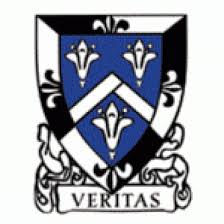
The other two most commonly quoted are "Laudare, Benedicere, Praedicare" (to praise, to bless, to preach)
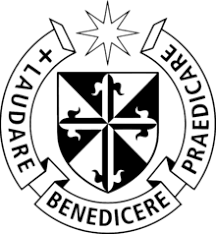
And the third motto "contemplare et contemplata aliis tradere" (to contemplate and hand on to others the fruits of contemplation) St. Thomas' defense of the revolution in understanding and practice gave rise to the motto of the Order - contemplata aliis tradere. Or to give it its fuller expression, contemplare et contemplata aliis tradere. Since the turn of the last century, that phrase has been often translated as "to contemplate and to give to others the fruits of contemplation." What we contemplate, as Dominicans, is Truth - with a capital T - Divine Truth. And it is that Truth which we have encountered in contemplation that we hand on to others through our preaching and teaching and other ministry. William Hinnebusch pointed out long ago in this regard that the simply word "Truth" does not merely point to the object of our collective vision and mission, but expresses exactly what we mean by "contemplation."
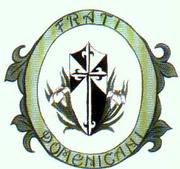
Dominican Cross

The Dominican Cross is a Gyronny Cross of the Ordo Praedicatorum (Order of Preachers).

The order was founded by St. Dominic to preach to the Cathars of southern France in the early 13th century. The French connection is seen in the Fleur de lis on the end of each cross limb. The Gyronny Cross reflects the characteristic Dominican habit, largely unchanged for 800 years: a long white tunic, contrasting with a black cloak, cappa (shoulder cape) and/or scapular. The black and white represents truth over heresy. In addition, the white reflects the joy and the purity of Christ, and the black reminds servants of the Lord of their humility and obligation for penance. These black cloaks led to the term 'Blackfriars', as opposed to Whitefriars (Carmelites) or Greyfriars (Franciscans). There is another, more subtle, meaning in the gyronny; not the black and white, but the word "gyronny" itself. A gyro, as any culinary expert will atest, describes the Greek method of preparing a lamb dish. "Gyro" is an old Greek word for "rotate", and used to describe the process of roasting meat on a spit, particularly lamb. Jesus, of course, is refered to as the Lamb of God.
St. Dominic
St Dominic - images of St. Dominic are very common in Latin countries. Usually you will be able to identify them easily by these attributes:-
Dog with Torch - The Dominican dog goes back to a vision St. Dominic’s mother supposedly had before she had him. Struggling with infertility, she was making a pilgrimage to the Abbey of Santo Domingo de Silos in Spain when she dreamed that a dog jumped from her womb holding a torch and set everything around them on fire.
Soon after, she conceived a son with her husband and named him after the 11th century St. Dominic of Silos, for whom the abbey she had visited had been named.
The dream was prescient due to a play on words in Latin: although Dominic called his order the Order of Preachers, it would later come to be known as the Dominicans;
in Latin, that’s Dominicanus, which is very similar to domini canis, or “dog/hound of the Lord.”
Lots of iconography related to St. Dominic and the Dominicans include a dog! But sometimes you have to look closely to catch it
Once you start looking for it, you start seeing it everywhere!
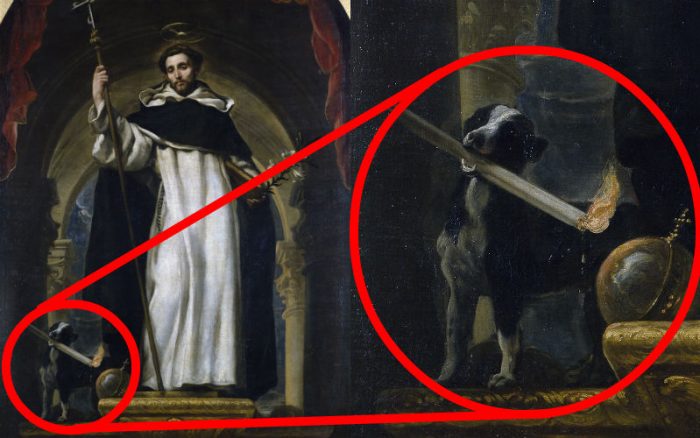
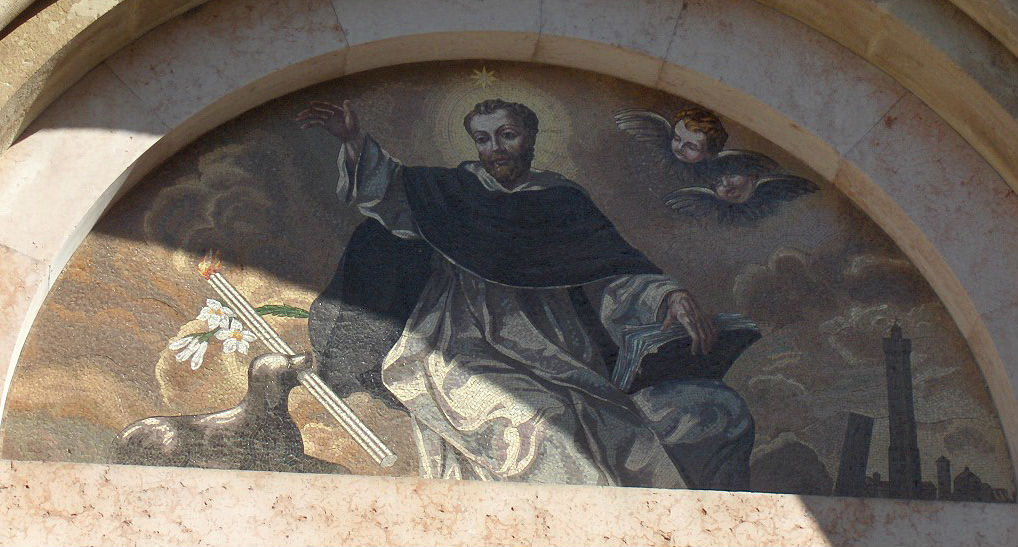
Given the order’s charism for zealous preaching of the Gospel, the story and the play on words seemed fitting! So, to this day, the Dominicans are nicknamed the “hounds of the Lord.”
-
Star on Forehead - The Legend also relates that when St. Dominic was a baby his godmother saw a star on his forehead during the baptism,
so another common attribute is a star either on the forehead or above the head (example).

-
Rosary - In the above example St. Dominic also carries a rosary, which a legend starting in the 15th century claimed had been
given him by the Virgin Mary.
-
Lilies - Yet another attribute is a lily or stalk of lilies, referring to St. Dominic's notable chastity.
-
Book and Staff - Finally, we often see St. Dominic with a book and a staff (example), a reference to a vision
recounted in the Golden Legend in which Peter and Paul give him these items and urge him to take them into the world and preach.
-
Saint's tonsure and black-and-white Dominican habit - A given image may use any combination of these six attributes, in addition to the saint's tonsure and black-and-white Dominican habit.
Sometimes, when the context has established who the figure is, the habit and tonsure may be the only attributes.
A Loaf of Bread
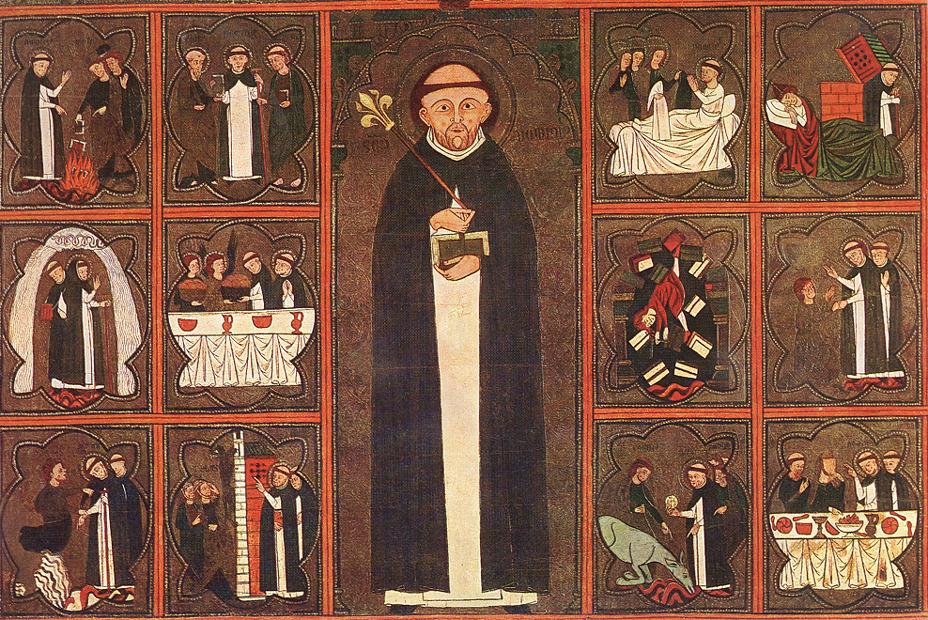
A loaf of bread he sometimes carries recalls a story of a miraculous supper, served to Dominic and his starving monks by angels. The story indicates that because the friars had given all they had to the poor, they had no food for themselves. Two were sent into the city to beg, but at the end of the day they had received nothing. When they returned to the convent, Dominic called them all to the refectory, and began to pray for bread. Two angels carrying loaves of bread in two white cloths that hung from their shoulders miraculously appeared in the refectory and began to serve the brothers, beginning with the youngest. When the last loaf was placed in front of Dominic, the angels disappeared.
The Orange Tree
The orange tree pictured is at Santa Sabina and is said to be a direct descendant of the one planted in Rome by Our holy Father Dominic in 1220. Apparently this was the first of its type to be planted in Italy. Saint Dominic planted an orange tree in the garden of the Priory of Santa Sabina in Rome. A series of oranges trees have grown in that garden for almost nine hundred years, each taken from a shoot of the previous tree. Dominic’s tree still produces oranges. Seeds from this tree have been used to grow other orange trees at various monasteries around the world. The Villa Sciarra in Rome has an orange grove grown in commemoration of the bringing of the plant to Italy by St. Dominic.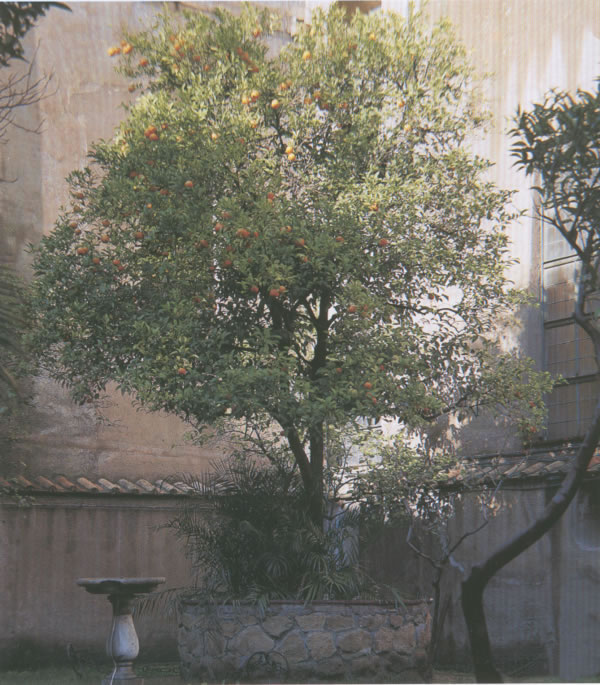
SPND - appended to a name
These letters appended to a Dominican's name as in God bless, in SPND, Sanctus Pater Noster Dominicus = SPND = Our Holy Father DominicLast Words of St Dominic
"Bury me under the feet of my brothers" - spoken by St Dominic at his death. - His friars had taken Dominic to a local Benedictine abbey, where they hoped he might rest more comfortably. Since death was approaching, the Benedictine superior intimated that he would be very pleased to bury Dominic in the abbey; the holy man would be given a prominent grave that would accommodate the numerous pilgrims who could be expected to visit his final resting place. When he caught wind of this, however, Dominic ordered his friars to take him home to their own priory. There, after his death, they were to place his body in an unmarked grave beneath the flooring of the house. “Bury me under the feet of my brothers,” he commanded them.
Dominican Clip Art Download Link